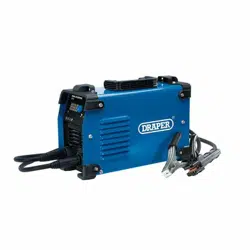Loading ...
Loading ...
Loading ...

–
4
–
– Sparks and molten metal are cast out during
welding. Take precautions to prevent fire igniting and
wear protective clothing.
– Sparks and molten metal can pass through gaps. Be
aware that fire can start out of sight. Flammables in a
locked cabinet may not be safe.
– Do not weld pressurised containers.
– Do not weld tanks, drums, or other vessels until they
have been correctly cleaned/prepared for welding.
– Always have appropriate and fully maintained
fire-fighting equipment suitable for the materials used
and for use in electrical environments available in
close proximity at all times.
– Keep clothing free from oil and grease.
– Wear a hat, flame-proof apron, woollen clothing,
gloves, long sleeve tops with closed neck, trousers
(without turn-ups) to cover non-slip boots.
– Protective head and shoulder coverings should be
worn when overhead welding.
– Avoid taking any fuels with you e.g. cigarette lighters
or matches.
– Hot spots and their immediate surroundings should
be observed until their temperature has dropped to
normal.
Personal Protection:
– The body should be protected by suitable clothing.
– The use of neck protection may be necessary
against reflected radiation.
– Wear safety glasses when chipping, wire brushing,
grinding, or when near cooling welds as metal filings
or slag can be thrown up. Fully enclosed goggles are
advisable.
– Arc machines generate a magnetic field which is
detrimental to pacemaker recipients. Consult your
doctor before going near welding equipment/
operations.
– The UV and IR radiation generated by welding is
highly damaging to the eye, causing burns. This can
also affect the skin. Protect the eyes and face.
– The face and eyes shall be protected by suitable
welding shields equipped with appropriate ocular
protection filters.
– Where environments are subject to pedestrians and
traffic ensure a protective screen is used to avoid
accidental arc glare.
- Do not weld in the vicinity of children or animals and
ensure no one is looking before striking up.
– In the welding environment, damaging levels of noise
can exist. Wear hearing protection if the process
dictates.
– Do not touch hot equipment or metal. Allow the weld
time to cool, use the correct tool and wear protective
welding gauntlets.
– Wear flame retardant clothing (leather, wool, etc.).
– Take care when adjusting or maintaining the torch
that it has had time to cool sufficiently and is
disconnected.
– The arc generates:
• ultra-violet radiation (can damage skin and eyes).
• visible light (can dazzle eyes and impair vision).
• infra-red (heat) radiation (can damage skin and
eyes).
– Such radiation can be direct or reflected from
surfaces such as bright metals and light coloured
objects.
Gas cylinders:
– Gas cylinders should be located or secured so that
they cannot be knocked over.
– Shield gas containers can explode if damaged. Take
care when handling.
– Ensure gas cylinders are shut-off when not in use
and between operations.
– Take care that no build-up of gas is permitted to form
in confined areas.
– Cylinders must be in an upright position at all times
during use and storage.
– The gas cylinder must never come in contact with
the electrode.
– Follow the manufacturer’s instructions for handling,
storing, and using the gas bottle correctly and safely.
– Use the correct equipment to connect the gas bottle
to the welding torch.
Limitations:
– Do not use for:
• operations in severe conditions (e.g. extreme
climates, freezer applications, strong magnetic
fields, etc).
• operations subject to special rules (e.g.
potentially explosive atmospheres, mines, etc).
• operations that require ingress protection greater
than IPX0, e.g. in rain or snow, etc.
General:
– Training should be sought out in:
• the safe use of this equipment;
• the processes;
• the emergency procedures;
– Welding power sources are not to be used for pipe
thawing.
– Take precautions against toppling over, if the power
source shall be placed on a tilted plane.
– All equipment should be kept in good working
condition, inspected and, when defective, promptly
repaired or withdrawn from service - All equipment
should be placed so that it does not present a
hazard in passageways, on ladders, or stairways,
and should be operated in accordance with the
manufacturer’s instructions.
Loading ...
Loading ...
Loading ...
